CAPTAIN JOHN DENNISON
BORN – Penrith, England, 1799. Held a commission in the British army serving in the Peninsular war and in India under Sir Charles Stapleton Cotton, Viscount of Combermere Abbey. Sir Charles was known for his “splendid appearance in battle” which earned him the moniker “Lion of gold.”
Dennison married Anne Sanderson of Edinburgh, Scotland. At that time he was involved in the management of the family distillery and brewing business.
In 1833, Dennison emigrated to Quebec, Canada with his wife and children Mary Elizabeth and John Jr. They had two more children, Henry and Anne. In 1837, Dennison rose to the field rank of captain serving with distinction with the Beach River volunteers during the Lower Canada (Quebec) Rebellion. Following the rebellion Dennison moved to Montreal, was demobilized in 1839 and there his wife died. Anne Dennison was buried at St. Andrews, Quebec.
Conflicting stories say that Dennison moved to Ottawa in 1852 or 1854 where he operated a distillery. In recognition of his military service Dennison received a free land grant, a common practice of the time. And so he moved his family, which according to one source included his wife and two sons (no mention of Mary and Anne unless the source confused his wife and daughter of the same name?) up the Ottawa River to Renfrew County where they settled on the Madawaska River. There he operated an Inn and the community that grew became known as Dennison’s Bridge.
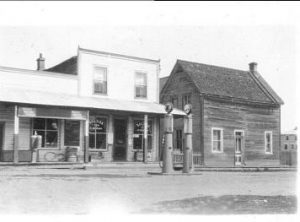
Speculation suggests that Dennison was positioning himself to take advantage of the anticipated flow of immigrants expected to settle the free land grants being offered along the developing Opeongo Road between the Ottawa River and Lake Opeongo. Known as the Opeongo Line this colonization road was to eventually connect the Ottawa Valley with Byng Inlet on Georgian Bay.
Viscount Combermere died in 1865. Daniel Johnson, a merchant, lumberman and land baron opened a post office in his store and to honour Captain Dennison’s former commanding officer Dennison’s Bridge was renamed Combermere.
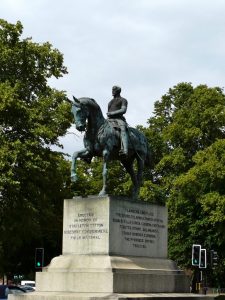
The 1871 the Renfrew County census lists John and Henry Dennison of Combermere. They were well established with close to 300 acres of land, a good percentage being listed as ‘improved’ or tillable. The brothers owned two boats with approximately 50 fathoms of net as well as copious amounts of grain, hay and produce. They had two horses, two fillies, several cattle and swine perhaps to sell to the lumber camps.
The Opeongo Line never reached its potential as the soil proved unsuitable to farming.
Captain Dennison was 70 or 71 when he decided to leave Combermere. Bear in mind many people of that era did not reach their Biblical three score and ten let alone have to ability to pioneer and resettle new territory. They paddled and portaged the Madawaska River, crossed Bark Lake, Victoria Lake and canoed a chain of smaller lakes to the Opeongo River. Ultimately they settled what became known as the Narrows which separated the east and south arms of Lake Opeongo. Son John cleared land on the east side, Henry on the west; the site of the Dennison farm. Keep in mind that Algonquin Provincial Park was not conceived until 1893.
THE BEAR
In June 1881 Captain Dennison and his 8-year old grandson Jackie paddled 8 miles northwest of the farm near the North Arm of Opeongo Lake to check a bear trap. Apparently Dennison left his long gun by a tree before descending into a ravine to check his trap. As one version of this tale tells it, as recorded in my book THE ALGONQUIN CENTENNIAL SERIES, the trap was well hidden and there was no evidence that the trap had been set. However, as Dennison approached for a closer look, an enormous black bear, “whipped into a fighting frenzy by the pain of the trap” tackled the trapper.
Dennison yelled telling Jackie to paddle for help.
One can only imagine the terror of that 8 mile paddle. Jackie arrived at home only to learn that his father was away hunting.
According to Wes Oram, the Captain knew there was a bear in the trap and it was hiding. The old man had attempted to kill the bear with a hatchet. Oram’s grandfather helped to bring the Captain’s body out.
According to author Kevin Callan that bear trap was set along the portage to Green Lake, today known as Happy Isle.
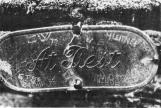
Captain Dennison was buried on his farm, not far from Opeongo Lake, surrounded by a split rail cedar fence measuring 6 feet by 8 feet that supported a copper or bronze plaque that read “At Rest”. The grave site, visited on September 26, 1978, was said to be in an almost “impenetrable” jungle of underbrush and only a handful of MNR employees such as Nick Martin, a fisheries research scientist at Maple, Ontario was one. He apparently first worked in the Park as a University of Toronto biology student in 1943. Writer Fiona Westner-Ramsay posted the photo of herself at the gravesite during a family canoe trip on Opeongo Lake.
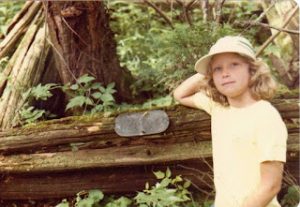
Eight years later, Dennison’s grandson Jackie, then age 16, died while on a moose hunt from a gunshot wound.
Sources: Ross Beagan, MNR Information Officer; Barry’s Bay This Week and the Algonquin Park archives.
THE TIMES TRAVELLER
In 1894, one year after the birth of Algonquin Provincial Park, The Bancroft Times began publishing. For the 100th anniversary Dave, Dean and Roger Walker, the owners and publishers, asked me to write a weekly column to honour that occasion. And so I began writing The Times Traveller column in 1993 in anticipation of this historic event. Previously, in 1992, I started to write a regular column featuring Algonquin Park in anticipation of its 100th anniversary. To my delight that column became so popular that I was asked to compile those columns in a book. In fact I was invited to the 100th anniversary celebrations at ‘The Park’ and was the first author to sell and autograph my book “the Algonquin Centennial Series” at the Visitor Centre. The material is sourced from the park archives and descendants associated with the park. The Algonquin Centennial Series is still available at Ashlies in Bancroft, the Old Hastings Gallery in Ormsby (Treats & Treasures) and Algonquin Park.
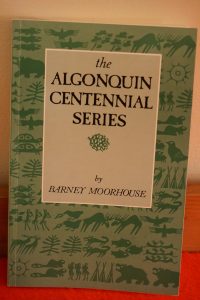
I uncovered the following information pertaining to the Dennison family while researching my weekly Time Traveller column, 51 columns a year, which ran from 1993- 2022 (1894 – January 1967). Of interest, what was to be a one year column proved to very popular with subscribers and thus continued until I decided to cap my ink well and put away the straight pen.
IN MEMORIAM – Dennison – In fond and loving memory of our dear daughter, Leaone, who departed this life on October 1st, 1930. Sadly missed by father, mother, brother and sister, Mr. and Mrs. C.B. Dennison and family, Combermere, Ontario.
Mr. Barney Dennison attended the funeral of the late John Kennedy at Boulter, Dec. 1953.
Mr. and Mrs. Pickering of Maple Leaf spent Monday at Mr. Barney Dennison’s.
COMBERMERE 1963 – Miss Ann Dennison of New Liskeard passed away last Monday in the North Bay Hospital. She was born, and had lived in Combermere many years. Her parents, Mr. and Mrs. John Dennison, had emigrated from England, and were among the first to settle here. Ann was the youngest daughter of a family of eight. A brother, Charlie Dennison, lived in Combermere. The only remaining member of the family is Mrs. Alec McMillan of New Liskeard with whom Ann had lived for a number of years. Ann was eighty years of age and Mrs. McMillan is now ninety-one.
BORN – Dennison – At Maryfield Hospital, Dundee Scotland, on Oct. 11th, 1944, to Pte. J.A.B. Dennison and his wife Isabella a daughter (Bernice Isabella).
The above birth announcement appeared in the 875th column of THE TIMES TRAVELLER. Elizabeth Wiggins phoned to say that her sister Bernice, mentioned in that announcement, now lives in Halifax. We talked about the Dennison family, specifically Capt. John Dennison after whom Dennison’s Bridge was named. According to Elizabeth, he wasn’t comfortable with the name and so he renamed it after Lord Combermere. Elizabeth said there is a plaque commemorating the memory of Captain Dennison near the bridge.
